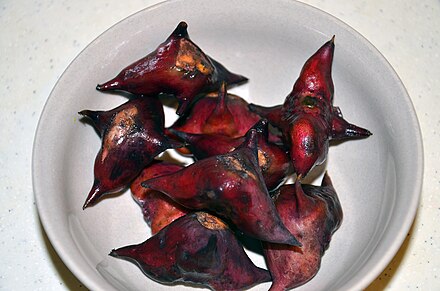Water caltrop
The water caltrop is any of three extant species of the genus Trapa: Trapa natans, Trapa bicornis and the endangered Trapa rossica. It is also known as buffalo nut, bat nut, devil pod, ling gok (Chinese: 菱角), ling nut, lin kok, ling jow, ling kio nut, mustache nut, singhara or water chestnut.[1]
The species are floating annual aquatic plants, growing in slow-moving freshwater up to 5 metres (16 feet) deep, native to warm temperate parts of Eurasia and Africa. They bear ornately shaped fruits, which in the case of T. bicornis resemble the head of a bull or the silhouette of a flying bat. Each fruit contains a single very large, starchy seed. T. natans and T. bicornis have been cultivated in China and the Indian subcontinent for the edible seeds for at least 3,000 years.
The water caltrop's submerged stem reaches 3.7 to 4.6 metres (12 to 15 feet) in length, anchored into the mud by very fine roots. It has two types of leaves: finely divided, feather-like submerged leaves borne along the length of the stem, and undivided floating leaves borne in a rosette at the water's surface. The floating leaves have saw-tooth edges and are ovoid or triangular in shape, 2–3 centimetres (3⁄4–1+1⁄4 inches) long, on inflated petioles 5–9 cm (2–3+1⁄2 in) long, which provide added buoyancy for the leafy portion. Four-petalled white flowers form in early summer and are insect-pollinated.[citation needed] The fruit is a nut with four 1 cm (1⁄2 in) barbed spines. Seeds can remain viable up to 12 years, although most germinate within the first two years.
The plant spreads by the rosettes and fruits detaching from the stem and floating to another area on currents or by fruits clinging to objects, and animals.
The unrelated Eleocharis dulcis is also called a water chestnut.[2] Eleocharis is also an aquatic plant raised for food since ancient times in China. E. dulcis is a sedge, whose round, crisp-fleshed corms are common in Chinese food.
The genus has an extensive fossil record, with numerous, distinctive species. Undisputed fossilized seeds have been found in Cenozoic strata starting from the Eocene throughout Europe, China and North America (though, the genus became extinct in North America prior to the Pleistocene).[4] The oldest known fossils attributed to the genus, however, are of leaves from Cretaceous Alaska, referred to the species, T. borealis.[5]


